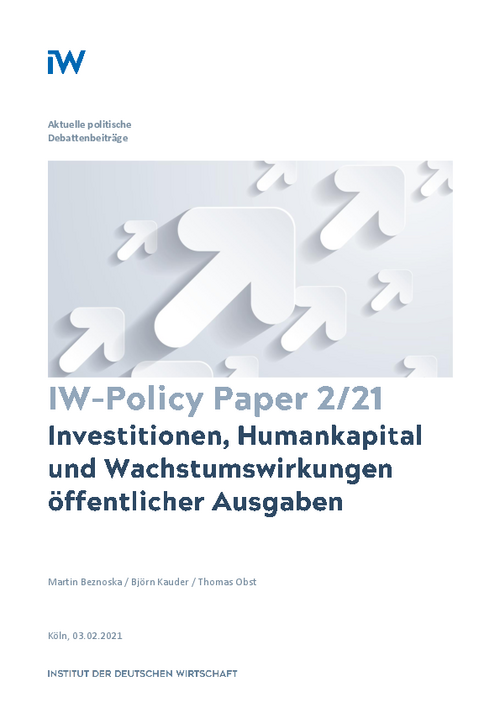Unlike public sector consumption, public investment is often regarded as contributing to growth. Yet while spending on "intangible" goods such as education does not count as investment, even though it is potentially growth-enhancing, expenditure with little to no effect on growth often does.

Investment, Human Capital and Growth Effects of Public Spending
IW-Policy Paper

Unlike public sector consumption, public investment is often regarded as contributing to growth. Yet while spending on "intangible" goods such as education does not count as investment, even though it is potentially growth-enhancing, expenditure with little to no effect on growth often does.
This raises the question as to whether the concept of investment should not be expanded to include government spending that has an impact on the future but is currently classed as consumption.
The traditional distinction between government consumption and public investment is not always clear. Expenditure is often defined as investment if it results in an asset which can be used repeatedly in the production process and potentially generates income in later periods, and which is at the free disposition of its owner or funding body. Educational expenditure is thus mostly defined as consumption because while it serves to generate future income, the productivity it builds up is person-related and thus not unrestrictedly available to those funding it.
In contrast to consumption expenditure, investment projects have a longer-term and sustained effect on an economy and a positive impact on its growth potential. Studies of the effect of fiscal policy measures on GDP find fiscal multipliers between 0.3 and 1.7, suggesting that government spending increases GDP but not necessarily private activity. Both macroeconomic models and the majority of empirical studies confirm the importance of human capital investment for economic growth. However, empirical identification is not without its problems and the results are much more heterogeneous than the literature often suggests.
In view of the relatively low rate of public investment activity in recent years, economists are calling for the creation of an investment fund of around 450 billion euros over the next ten years. The selection criterion for projects to be financed by such a fund should not be whether they meet the classical definition of investment, since, especially in the case of infrastructure projects, particularly on the municipal level, personnel costs will often be an essential component. Rather, goal-related cost-benefit analyses should be conducted to ascertain the long-term impact of each individual investment project. The projects should also meet the criterion of additionality. For projects that include ongoing expenditure, continued financing beyond the timespan of the fund needs to be secured.

Martin Beznoska / Björn Kauder / Thomas Obst: Investitionen, Humankapital und Wachstumswirkungen öffentlicher Ausgaben
IW-Policy Paper

More on the topic

Effects of Public Investment on Companies in Germany – Results of the IW Business Survey
Weak public investment activity in Germany has contributed to the low productivity growth of the last decades. Even maintaining the contribution to growth of state-owned capital stock at the already low level of the 1990s would have required an additional ...
IW
Reform of EU-fiscal rules: Lindner's ideas have merit
The German government's proposal to introduce a fixed limit on government spending growth for highly indebted member states in the course of the reform of the Stability and Growth Pact makes sense. Given the macroeconomic environment, such a minimum ...
IW